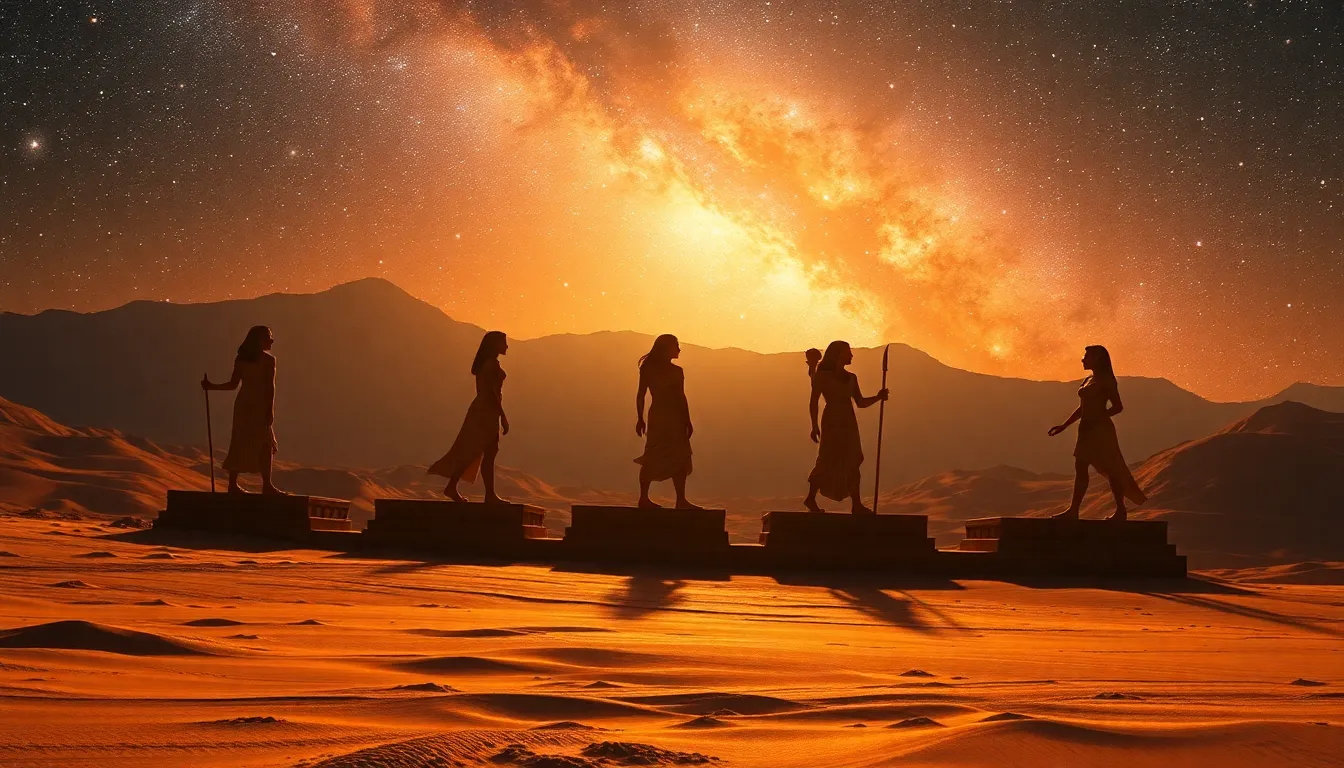The Legend of the Seven Sisters: The Pleiades in Egyptian Mythology
I. Introduction
The Pleiades star cluster, also known as the Seven Sisters, is one of the most famous and easily recognizable clusters in the night sky. Comprising seven main stars, the cluster has captivated humanity for millennia, serving as a source of inspiration and a focal point in various mythologies and cultures.
Across different civilizations, the Pleiades have been associated with a range of meanings, from agricultural indicators to symbols of mythological stories. In ancient Egypt, the Pleiades held a significant place in both astronomy and religious practices, intertwining the practical with the spiritual.
This article delves into the rich tapestry of Egyptian mythology surrounding the Pleiades, exploring their historical context, mythological significance, and lasting legacy.
II. Historical Context of the Pleiades in Ancient Egypt
Ancient Egyptian civilization was deeply intertwined with the stars and celestial bodies. Astronomy played a vital role in their society, influencing agriculture, religion, and daily life.
The Egyptians were adept observers of the night sky, and they recognized the Pleiades as a significant star cluster. This recognition was reflected in their calendar, which was closely aligned with celestial events.
- Celestial Significance: The stars were often seen as manifestations of the gods and were integral to the Egyptian understanding of the universe.
- Religious Importance: The Pleiades contributed to the mythology surrounding creation and the afterlife.
- Calendar Role: The heliacal rising of the Pleiades marked important agricultural seasons, such as planting and harvesting.
III. The Seven Sisters: Mythological Representations
In Egyptian lore, the Seven Sisters were often associated with various goddesses and mythological narratives. They were seen as guardians of fertility and abundance, reflecting the agricultural lifestyle of the Egyptians.
Comparatively, other cultures, such as the Greeks and Native Americans, also revered the Pleiades, attributing different stories and meanings to the star cluster.
- Egyptian Lore: The Seven Sisters were connected to the goddess Isis, who represented motherhood and fertility.
- Cross-Cultural Comparisons: In Greek mythology, the Seven Sisters were associated with the nymphs, while in Native American traditions, they often represented the spirits of ancestors.
- Key Figures: Other deities linked with the Pleiades include Hathor and Neith, further enriching their narrative in Egyptian mythology.
IV. The Pleiades and Egyptian Deities
The connection between the Pleiades and major Egyptian deities is profound. The stars not only served practical purposes but also held symbolic meanings that resonated within the religious framework of ancient Egypt.
The symbolism of the Seven Sisters was particularly tied to themes of fertility and agriculture:
- Fertility: The Pleiades were often seen as a sign of fertility, heralding the arrival of the inundation season essential for agriculture.
- Agricultural Rituals: Various rituals and offerings were performed to honor the deities associated with the Pleiades, ensuring a bountiful harvest.
V. Astronomical Significance of the Pleiades
The Pleiades have a distinct visibility in the night sky, especially during certain seasons, which was crucial for the agricultural practices of ancient Egypt.
Their influence extended beyond agriculture to navigation and timekeeping:
- Visibility: The Pleiades are best seen in the pre-dawn sky during spring, marking a critical time for planting crops.
- Agricultural Influence: The heliacal rising was a signal for farmers to begin sowing seeds.
- Navigation: The cluster served as a navigational aid for travelers and traders, guiding them through the desert.
VI. Artistic Representations of the Seven Sisters
The Pleiades have been represented in various forms of Egyptian art, from tomb paintings to inscriptions. These artistic expressions reflect their significance in the mythology and daily life of ancient Egyptians.
Hieroglyphs and inscriptions often depicted the stars and their associations with deities:
- Artistic Depictions: The Pleiades were sometimes illustrated alongside agricultural scenes, emphasizing their role in fertility.
- Hieroglyph Analysis: Inscriptions referencing the Pleiades often included prayers and offerings to associated deities.
- Literary Influence: The stars also inspired Egyptian poetry, which highlighted their beauty and their connection to the divine.
VII. Legacy and Cultural Impact
The legacy of the Pleiades in Egyptian culture persists even today. Their influence extends to modern astronomy and folklore, demonstrating the enduring fascination with these stars.
In contemporary society, the Pleiades continue to appear in popular culture:
- Modern Cultural References: The Pleiades are often referenced in literature, music, and art, maintaining their status as a symbol of mystery and beauty.
- Astronomical Connections: The cluster remains a focal point for astronomers and sky watchers alike, linking past and present.
VIII. Conclusion
The Pleiades hold a significant place in Egyptian mythology, representing a rich blend of astronomy, agriculture, and spirituality. Their stories reflect universal themes of life, death, and rebirth, which resonate across cultures.
As we explore the celestial myths from various cultures, the Pleiades remind us of our connection to the stars and the stories they tell. The Seven Sisters continue to inspire wonder and curiosity, inviting us to delve deeper into the mysteries of the universe.




